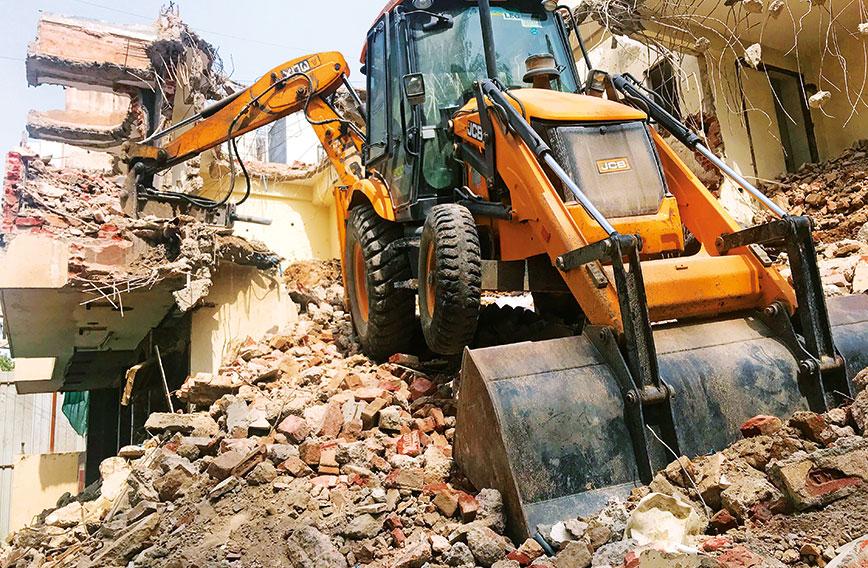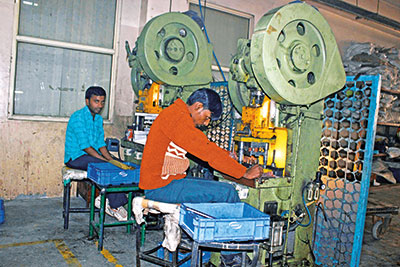
The construction and real estate sector is suffering a steep deficit of 30 percent workers
Toxic shop floors keep workers away
By Rajiv Khandelwal
WITH A DECADE of shop floor experience, Harlal is an expert in firing up and managing boilers in a textile factory. He has been working in Rajkot, Gujarat, one of the centres of the Indian textile industry. Despite the importance of his role and many years of service, Harlal was earning just Rs 350 for a day’s work. His wife made another Rs 200 a day from sweeping and cleaning the mill. The family lived in the mill despite the heat and smoke on the premises.
A year ago Harlal found himself accused of selling coal on the side and pocketing the money. He swears on his young sons that he stole nothing but, facing a backlash from his contractor, he had to flee Rajkot and return to his village in Karauli, in Rajasthan. After building up a debt of Rs 40,000 in the village, Harlal is back in Rajkot with the same contractor who now pays him only partially every week and keeps the remainder for payment on a later date.
Stories like Harlal’s abound in the country. Paltry wages, dismal workplace conditions and the absence of rights have increasingly made employment an untenable burden. Workers are opting to stay away or enter and exit quickly, which has been showing up now in data.
The Manpower Group Employment Outlook Survey for 2021 reports that a whopping 43 percent of all employers are unable to make steady hires and are struggling to find recruits across all levels.
So, while media reports abound with stories of rapid economic recovery after the battle with COVID-19, there are continuing laments of worker shortages in several sectors.
For instance, the construction and real estate sector is suffering a steep deficit of 30 percent workers and its growth plans will need a million workers more in the next two years.
It would appear that in a reviving economy everyone will find work. If not locally available, work will certainly be available at some distance away. If it is difficult to find employment by one’s own devises, it will come through a contact, an intermediary or an agent. Nobody needs to go without work unless they choose not to work at all.
It is, therefore, surprising that thousands exercise the option to not work. Or exit work quickly if they do decide to work. Surely, fears of COVID-19 and the spectre of lockdowns aren’t keeping people away from work anymore.
It certainly did impact the willingness among migrants to get to work — especially as employment also recovered very slowly after frequent shutdowns, disrupted supply chains and drying up of orders. However, now that the economy is throbbing again and needs workers, why are workers not showing up?
 Many more factories now hire workers on contract
Many more factories now hire workers on contract
The answer is not in the quantum of jobs being created but in the quality of the ones on offer. Jobs for millions were a bad deal before COVID-19 and they continue to be a bad deal now. Until the fundamentals of wages and work conditions are fixed it is doubtful that Indian industry will have a just share of its urgently needed workforce.
ABYSMAL WAGES
Wages, for labouring millions in India, remain appallingly low. The minimum wages mandated by law are still way short of the aspired living wage which might allow wage-dependent households the chance to lead a well-nourished, wholesome and dignified life. Studies estimate that minimum wages elude over 60 million workers — a sizeable proportion of the entire workforce. Add to this the reality that in the waged work spectrum there is a gap of at least 33 percent between what women and men earn for the same quantum or nature of work.
The India Wage Report, published by the International Labour Organization (ILO) in 2018, is amongst the most credible recent accounts of India’s wage structure and its governing policies. The report refrains from making any indicting comments on the underlying factors of low wages but it does assert that “low pay and wage inequality remain a serious challenge to India’s path to achieving decent working conditions and inclusive growth”.
Barely half of India’s workforce earns a wage and the proportion of wage-earners rises very slowly over time — for example, from 46 percent in 1993-94 to just 49 percent in 2011-12.
The work of the remaining workforce is not waged — because of the high proportion of self-employed workers and home-based workers (who are paid piece-rate), and people working as unpaid helpers in their family enterprises. Such work can be low-return and extractive.
The national floor wage announced in 2017 was shockingly low — just Rs 176 per day. The government has yet to consider recommendations of its own committee that proposed a floor wage of Rs 375 (with regional variations). States are free to determine higher minimum wage rates but these still remain way below fair standards, barring some exceptions like Delhi or Kerala.
India is witnessing a massive increase in the number of contract labour everywhere. The Annual Survey of Industries (ASI) says that there has been a surge in the use of contract labour in the organized manufacturing sector.
The share of contract labour in total employment increased sharply from 15.5 percent in 2000-01 to 27.9 percent in 2015-16 (a huge escalation in real terms given India’s labour-intensive workforce). The increasing use of contract workers who are not employed directly by the employer, but by an intermediary or contractor, reflects significant informalization of the workforce.
 Women are paid much less than men
Women are paid much less than men
This has major implications for what workers can claim as a rightful wage or entitlement: usually contract workers will go without stable, written contracts, social security coverage like insurance, pension or paid leave — all of which are needed for a workforce to experience well-being. Payments determined on the quantum of work done are often a means of paying workers less than the market wage.
The payment of wages through intermediaries and contractors results in arbitrary commissions and cuts, which result in low returns for workers. The reality of wage fraud in such systems is a major hindrance to employment environments becoming stable.
The data is disturbing: 67 percent of the Indian workforce go without written job contracts, 52 percent receive no paid leave, and 54.2 percent are ineligible for social security according to the Periodic Labour Force Survey (PLFS) report of 2019-20.
Poor wages, especially in cities that attract millions of migrant workers, result in workers making compromises on what they eat and where they live. One-fifth of Indian workers above 45 years are undernourished, according to its first Longitudinal Ageing Study. Most informal workers live in unthinkably squalid conditions in cities. There is just not enough income to buy or prepare three nutritious meals or rent dignified spaces, and workers cut back on these costs in order to save enough for remitting back home.
However, this condition of work and living is inherently unsustainable. It is not surprising, therefore, that workers from urban settings return frequently to their rural homes and often just quit their work on account of sheer exhaustion and morbidity.
Even in so-called high growth potential sectors like logistics and retail, earnings barely match fair standards of compensation. Hours of work are long and earnings are often linked to efficiency or outputs which unfairly pressure workers into risky behaviour. No wonder that the average retention of workers in these “future of work” spaces is very short.
UNEASY ENTRY
Take the case of Prashant, who escaped from a harrowing work situation in a hotel on the Indore-Bhopal highway. He had to work nearly 14 hours every day and was paid a paltry Rs 5,000 per month — that too not regularly. Back in his village near Banswara town, Prashant contacted the STEP Academy where he signed up to be trained as a two-wheeler repair mechanic. Unfortunately, he did not have the capital to start a workshop of his own. He also needed to spend time to continue his practical training on the job.
An Udaipur-based service franchise of a major automobile brand took him in at a stipend of Rs 3,000 per month, guaranteeing him a fuller salary after six months. Prashant could only survive three months on this earning and he finally quit to go back to his village. He has started to go find work as a daily wage labourer in Banswara. He says he will get back to Indore one day again — at least the food was not bad in the hotel!
Prashant’s experience is common among people trying to find their way in life. But there seems a general unwillingness to accept this reality. When we talk to any reputed provider of skilling and vocational training or to a placement company, we hear an unequivocal lament — the youth do not stay in jobs despite “attractive terms”. Many hold MGNREGA responsible for creating a low-paid, lazy alternative in rural areas which is coming in the way of higher aspirations among youth.
Several establishments, such as in the hotel industry, practise engaging a large number of trainees as a proxy workforce. Trainees will undertake the most tedious of all work in the guise of being trained for a very small stipend. Our experience suggests that the hospitality industry has worked out a full model of having a cheap workforce based on the large supply of hotel trainees made available to it through private institutions. The tedious and high-pressure work conditions that are not adequately compensated result in young workers moving on when they can’t take it any longer or something marginally better comes along.The universal attrition we encounter among young and freshly skilled workers should really be attributed to extremely low entry-level wages. These vary from sector to sector, but mostly entry wages are in fact no better than stipends such as Rs 4,000 per month in small hotels or units with the offer of dilapidated accommodation and possibly a meal thrown in for good measure.
|
|
Probe this further and we find that skilled personnel at entry level in many employment sectors are forced to work on sub-survival wages. Retail, automobile repairs, logistics and delivery and manufacturing have a long gestation period for wages to become equal to acceptable levels.
The severe under-pricing of the trainee hits young skilled workers even in the otherwise high-demand construction sector. Freshly trained plumbers, slab workers, electricians, marble fitters and so on will have to work for long on low wages before they come into their own as self-employed technicians able to command a respectable wage. It takes enormous tenacity (and subsidy from the family) to survive this uncertain period of low-waged existence. In our skilling programme there is a pensive record of trained youth returning to labour nakas and hiring themselves out to work as unskilled workers because it brings them a higher daily wage.
Several labour recruiters tell us to help them identify pools of unskilled boys and girls (“We will mould them.”) and not bother with skilled youth. With this frequently repeated refrain the message to young people in general is that training is not worth its effort, price and time — except for the laminated and stamped certificate which holds a vague promise of a formal job in future.
WORKSITES OR WAR ZONES?
Shankari fell from the first floor scaffolding of a building under construction. She miraculously survived the fall, but suffered five fractures all over her frail body. She did not have proper shoes as she made her way up the ramp carrying a 40-kg load of bricks, resulting in losing her footing. The contractor rushed her to the hospital and got her first-aid.
Shankari, however, needed surgery in her arms and also a test to assess if she had suffered a head injury internally. The contractor threw up his hands over spending more money and the building company refused to offer any assistance. Shankari had to return to her village in a private vehicle, paying an enormous Rs 26,000 for the journey. Her sons are paying off this debt by working in a neighbouring mine.
The average Indian worker is exposed to possibly the most grave and risky conditions anywhere in the world. The number of accidents (especially life altering or fatal) is alarmingly high and remains seriously under-reported.
The Labour Bureau under the Ministry of Labour and Employment collected data on injuries and fatalities till 2017 and documented nearly 6,000 injuries and just over a thousand deaths across the country. Even this is serious under-reporting of injuries — possibly just 10 percent of the total accidents and deaths that occur. And this data does not even represent the informal sector, which employs a majority of workers.

More than 100 workers lose their fingers and limbs in Haryana's auto clusters every month |
n unverified press report in 2018 claimed that there are over 48,000 fatal accidents on worksites in India annually. Of these, construction sites account for nearly a quarter of all deaths while spaces such as manufacturing, processing, recycling, waste sorting and transportation, etc are virtual war zones for workers who remain untrained and unarmed to keep themselves safe.
In the automobile clusters of Gurugram, Faridabad and Manesar, a notable report by Safe-in-India estimates that a hundred workers lose their fingers and limbs every month. These are workers employed in small units that supply parts to established automobile brands such as Maruti, Honda and Ford.
Just in the past two years, we have intervened in over 150 cases of worker accidents in a mid-size textile hub of Ahmedabad. Not far from Ahmedabad we have recorded over a hundred electrocutions and injuries involving crushed limbs among workers of power looms in Surat. There is an unprecedented scourge of silicosis and similar occupational diseases in mining, quarrying and stone work across the country.
What further aggravates the risk for workers is the overlooked reality of shelter on hazardous worksites. Millions of small units double as homes for workers by night even if the shop floor is highly risky or hazardous. It is all too often that workers will get trapped in avoidable accidents that might have been prevented if they had an option for housing other than their toxic workplace.
There is an unusual aversion to implementing safety standards at worksites despite the costs being just marginal. Safety measures are seen as an impediment to productivity and are often just showcased to tick the boxes of legal compliance. Of course, the common solution is to push the onus of safety on the workers (“We give them masks and helmets but they don’t want to wear them!”) rather than focus on making the sites of work safer and accident-proof, or investing in mechanical safety protocols.
Larger industrial players driven by the compliance compulsions or obligations to their global buyers often adhere to high safety standards — at least in their own facilities and for their core, on-roll employees. Yet downstream in the supply chains of even fully compliant industries safety conditions for workers may be very compromised. They are neither being assessed nor being acted on for improvement.
The missing healthcare services in the dense and often degenerated neighbourhoods of workers speaks of huge intra-urban disparities. To fill the vacuum of public care services, a flourishing business of quackery exists in workers’ clusters — the quacks are the first port of call for workers battling injuries and illnesses. Out-of-pocket expenditures on healthcare can make deep dents in the earnings of workers, who often prefer to return home than to languish in cities. Dangerous and accident-prone work conditions have a damaging impact on workers’ stability and productivity.
NO TIME TO LOSE
A disturbing piece of data that came to public light a couple of years ago continues to haunt me. The National Crime Records Bureau (NCRB) published an analysis of recorded suicides which stated that 23 percent of all suicides were committed by daily-wage workers. Of course, the NCRB makes a disclaimer about relating occupational engagement to suicidal tendencies, but the connection cannot be wished away. The poverty of daily-wage work must aggravate psychological isolation and stress.
The narrative of jobs and employment generation rarely focuses on the dignity of work. Decent, well-remunerated and safe work is a prerequisite to a productive workforce which in turn forms the very foundation of a flourishing economy. Instead of correcting the very fundamentals of how work is transacted and workers are treated, we place an oversimplified focus on skilling and vocational training or on data collection and mapping to help create digital platforms of interface between employers and workers. These can only become relevant and possibly useful if the more structural issues of work begin to be addressed — fair wages, social security, safety at work, gender parity, access to housing and food, access to justice and opportunity to all workers for participating in the future of work.
Rajiv Khandelwal is co-founder of the Aajeevika Bureau, which supports workers in the unorganized sector. www.aajeevika.org
Comments
Currently there are no Comments. Be first to write a comment!




